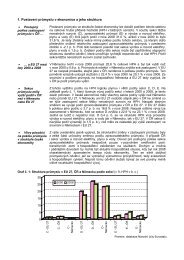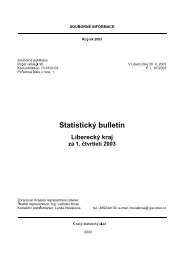Statistická ročenka Olomouckého kraje 2011 - Český statistický úřad
Statistická ročenka Olomouckého kraje 2011 - Český statistický úřad
Statistická ročenka Olomouckého kraje 2011 - Český statistický úřad
You also want an ePaper? Increase the reach of your titles
YUMPU automatically turns print PDFs into web optimized ePapers that Google loves.
panel of chosen dwellings varies during the survey. Each quarter 20% of newly chosen dwellings are incorporated into<br />
the panel and after five quarters being on the panel they are dismissed from.<br />
The decisive criterion for surveyed characteristics of every respondent is the respondent’s actual activity on the<br />
labour market in the reference week. If a respondent stated that he/she had worked at least one hour in the reference<br />
week, he/she is strictly classified, according to the ILO methodology, as a person in employment.<br />
All tables give average annual data for respective years.<br />
Data are collected by sample methods and therefore their accuracy is becoming lower as the sample size<br />
decreases. The annual averages lower than 3 000 persons are considered as low reliability data and annual data for<br />
a number less than 500 persons are not published at all as their relative standard deviation is higher than 50%<br />
(represented by dots in tables). For all data obtained from the sample survey the 95% confidence interval can be<br />
constructed, i.e. the interval, in which the real value of the estimated indicator lies with the 95% probability. The interval<br />
size is affected by both frequency of the characteristic surveyed in respective region and the sample size in the region.<br />
Data on the number of employees and average gross monthly wages are drawn from results of the processing of<br />
annual statistical questionnaires. Territorial breakdown of the data by region is obtained directly from the reporting units,<br />
including enterprises with up to 20 employees. It is carried out depending on the location of actual workplaces of<br />
employees, by the so-called workplace method (Tables 9-8 and 9-9). However, a more detailed territorial breakdown,<br />
for example, by districts, is impossible.<br />
Data breakdown by industry for the years 2006–2009 have been newly processed according to the CZ-NACE<br />
classification (effective since 1 January 2008) and therefore data on employees and wages are for the time being<br />
marked as preliminary.<br />
Since 2009 changes to methodology of surveys and presentation of results of the labour and wage statistics have<br />
occurred. Data published by registered office of the reporting business (so-called enterprise method) are newly<br />
shown including enterprises with less than 20 employees emphasising average wages of employees recalculated to<br />
the full time employee equivalent taking into account the work hours.<br />
Data are classified to industries by principal activity of the whole enterprise (according to the CZ-NACE classification,<br />
which is comparable with international classifications).<br />
Data in Table 9-105 are drawn from the results of the processing of quarterly statistical questionnaires and the territorial<br />
breakdown is carried out by head office of the reporting business - the so-called enterprise method. It means that even<br />
though a business has subordinated organizational units (plants, branches, shops, etc.) located in other region, it is<br />
classified as a whole to the region, in which it has its registered office. Data are shown both according to the original<br />
methodology and the new methodology as well.<br />
The data shown in Tables 9-106 and 9-107 are for the business sphere taken over from the Information System on<br />
Average Earnings (ISAE) of the Ministry of Labour and Social Affairs of the CR; the system contains data from a sample<br />
survey in businesses with 10+ employees. Data for the non-business sphere are taken over from the Information<br />
System on Salaries (ISS) of the Ministry of Finance of the CR. These sources provide information on individual<br />
employees. The average wage is calculated from the paid working hours of the employee (unpaid absence, illness, etc.<br />
are not included) and therefore is not identical with the average wage from the business surveys of the CZSO, which is<br />
calculated from the registered number of employees (headcount) (Tables 9-8 and 9-9 or Tables 9-103 to 9-105).<br />
The wage median is the value of the employee’s wage in the middle of the wage distribution. This means that one half of<br />
wage values is below the median, while the other half is above it.<br />
The data on the number and structure of unemployed job applicants and on the vacancies are taken from the<br />
Information System of the Ministry of Labour and Social Affairs of the CR (according to the records of labour offices).<br />
Unemployed job applicants are citizens permanently residing in respective areas, who have no formal job or similar<br />
attachment to any employer, are not gainfully self-employed, and have asked the labour office to find a job for them.<br />
Available unemployed job applicants are registered job applicants (including the EU and EEA citizens), ready to take<br />
a job immediately, when an appropriate one is offered, because there is no objective obstacle for them to become<br />
employed.<br />
The partly unemployed are registered job applicants with additional earnings (coming from an activity based on<br />
employment or service relationship, if performed in shorter hours than a half of the determined working hours, or under<br />
contracts for work carried out outside contracts of employment provided that their monthly earnings or remunerations per<br />
month do not exceed a half of the minimum wage).<br />
The registered unemployment rate according to the methodology valid until 30 June 2004 is the ratio (expressed<br />
as percentage) of the number of the unemployed job applicants in the numerator (as at the end of the reference period)<br />
and the available labour force (i.e. the employed measured by the LFSS and unemployed job applicants) in the<br />
denominator. The registered unemployment rate according to the methodology valid since 1 July 2004 is the ratio<br />
of the number of available unemployed job applicants in the numerator and the sum of the number of the employed<br />
measured by the LFSS plus the number of working foreigners registered at the labour offices or foreigners with valid<br />
work permits or trade licences plus the number of available unemployed job applicants (moving annual average) in the<br />
denominator.<br />
Data for employed foreigners are based on the records of:<br />
196<br />
<strong>Statistická</strong> <strong>ročenka</strong> <strong>Olomouckého</strong> <strong>kraje</strong> <strong>2011</strong>














